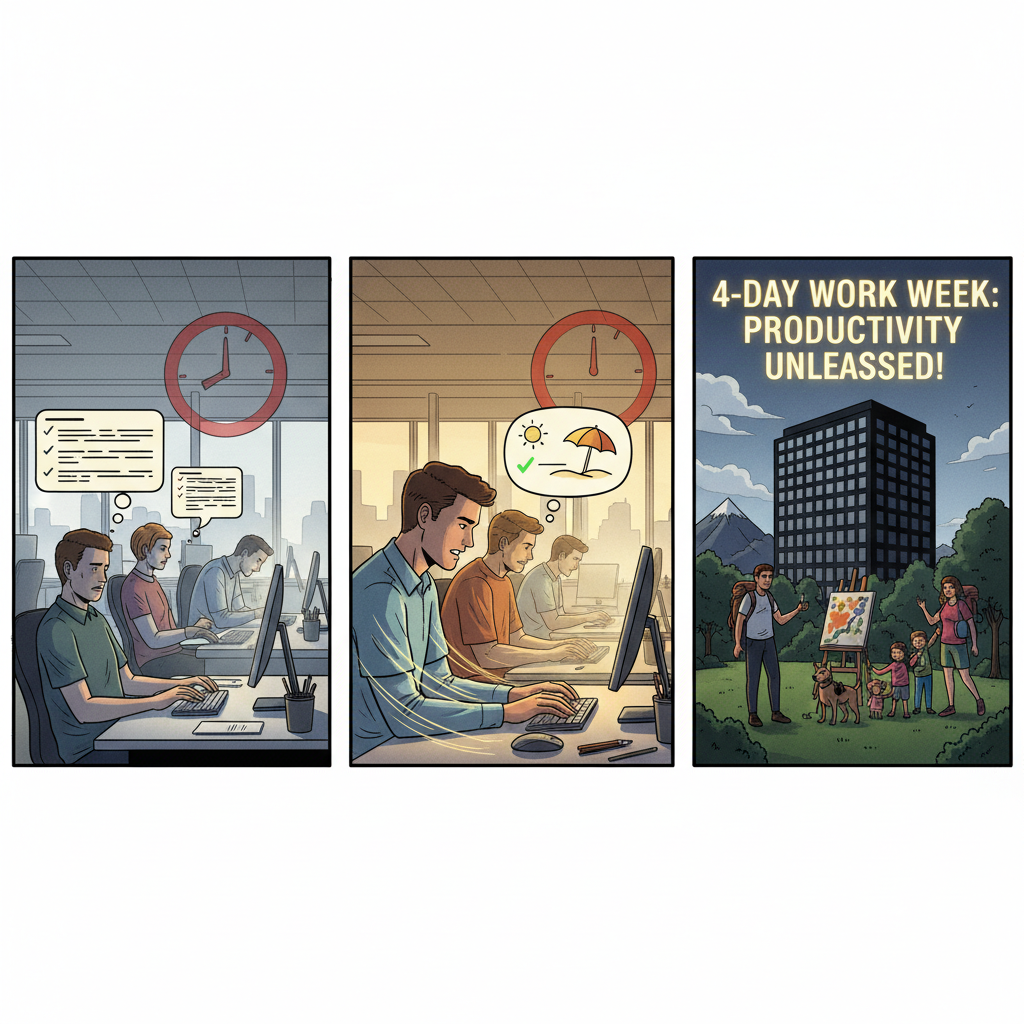Introduction
The traditional five-day work week has long been a symbol of modern employment a routine that defines when we work, rest, and live. But as the world of work evolves, so do our ideas about productivity and balance. The 4-day work week is one of the most revolutionary shifts in employment today, and it’s reshaping how businesses and employees think about success.
What began as an experimental policy in a few forward-thinking companies has now become a global movement. From the UK and Japan to the United States and India, organizations are reimagining schedules to boost productivity while improving mental health and job satisfaction. Studies show that employees working four days a week often accomplish the same or even more than those working five.
As we enter 2026, the 4-day work week isn’t just a workplace perk it’s becoming a defining feature of the future of employment. This blog explores how this trend began, what makes it work, the industries adopting it, and what it means for the future of work-life balance.
The Evolution of the Work Week: From Tradition to Transformation
A Brief History of the 5-Day Week
For most of the 20th century, the 5-day, 40-hour work week was the global standard. It emerged during the Industrial Revolution, when factory schedules demanded long, structured hours. In 1926, Henry Ford famously introduced the two-day weekend for his workers, believing that more rest would increase productivity and it did.
But a century later, the digital economy operates differently. Work is no longer tied to factory floors or physical presence. With technology, automation, and remote collaboration, employees can achieve more in less time. The 5-day schedule, once revolutionary, now feels outdated to many professionals who crave flexibility and purpose.
The Pandemic Shift
The COVID-19 pandemic accelerated the rethink of traditional work. Remote work became the norm, and organizations realized that productivity wasn’t tied to office hours. As burnout and mental health issues surged, many companies began experimenting with shorter weeks to combat fatigue and improve engagement.
What they found was surprising cutting a day didn’t reduce performance. Instead, it often increased focus, creativity, and efficiency, proving that results matter more than hours worked.
How the 4-Day Work Week Works And Why It’s Effective
The 100-80-100 Model
Most 4-day work week trials follow what’s called the 100-80-100 model:
- Employees receive 100% pay
- Work 80% of the time
- Deliver 100% productivity
The idea isn’t to cram 40 hours into four days but to optimize workflows, reduce distractions, and prioritize meaningful work. Meetings are shortened, communication is streamlined, and focus time increases. Companies like Microsoft Japan and Buffer have reported up to 40% gains in productivity using this model.
Improved Mental Health and Work-Life Balance
Shorter weeks have also led to happier, healthier employees. A landmark UK pilot involving 61 companies found that 71% of workers reported lower burnout and 60% felt a better balance between work and personal life. With an extra day off, employees spend more time with family, rest better, and pursue personal passions leading to higher motivation during the workdays.
This healthier rhythm creates a sustainable workforce, reducing turnover rates and absenteeism. When employees feel valued and energized, companies benefit from increased loyalty and innovation.

The Role of Technology
Technology plays a key role in making the 4-day work week successful. Tools like Slack, Asana, and Notion streamline project management, while automation handles repetitive tasks. AI-driven systems optimize workflows and scheduling, allowing teams to do more in less time.
As workplaces become smarter, it’s no longer about working longer it’s about working better.
Industries Embracing the 4-Day Work Week
Tech and Creative Industries Lead the Way
Unsurprisingly, tech and creative industries have been at the forefront of this change. Companies in these sectors rely heavily on innovation and talent retention and flexible schedules help achieve both. Startups, design agencies, and marketing firms have shown that productivity thrives when employees have more control over their time.
For example, Basecamp and Bolt adopted a permanent 4-day week after successful trials, reporting higher output and better employee satisfaction. These companies noticed that workers were more focused and less likely to experience burnout.
Public Sector and Education
Even government and educational institutions are joining in. Iceland became one of the first nations to test the 4-day model across public services, with 86% of the workforce eventually gaining shorter hours without pay cuts. The results showed stable or increased productivity and happier workers.
Similarly, schools in the U.S. and Europe have begun experimenting with compressed schedules for teachers and staff, aiming to reduce stress while maintaining quality education.
Healthcare and Manufacturing Explore Flexibility
Though more challenging, healthcare and manufacturing sectors are also exploring shorter work schedules. Rotational 4-day systems and smart automation tools help maintain coverage without reducing service quality. Hospitals in Sweden and Canada have piloted six-hour days or four-day rotations to boost employee morale and patient care.
These examples prove that with the right planning, even time-intensive industries can adapt to modern, balanced work models.
The Challenges and Criticisms of a Shorter Week
Not a One-Size-Fits-All Model
While the 4-day work week is promising, it’s not universally practical. Certain industries such as logistics, retail, and emergency services depend on consistent, real-time operations that make shorter schedules difficult. Some companies fear that compressing hours may lead to increased pressure and burnout if workloads aren’t adjusted properly.
The success of a 4-day model depends on clear communication, effective management, and realistic expectations. Employers must focus on output, not hours, and ensure that workloads remain balanced.
The Cost of Transition
For organizations used to traditional systems, transitioning can be costly at first. Redesigning processes, adjusting payroll systems, and testing productivity metrics require time and resources. However, long-term studies show that savings from reduced turnover, absenteeism, and higher engagement often outweigh the initial costs.
Cultural Resistance
Work culture is another barrier. In many countries, long hours are still associated with dedication and success. Overcoming this mindset requires leadership commitment and a cultural shift toward valuing outcomes over time spent. The change starts from the top when leaders model balance, employees feel empowered to follow.
How the 4-Day Work Week Is Shaping the Future of Employment
Redefining Productivity
The 4-day work week challenges one of the oldest myths in modern employment that productivity equals time spent. In reality, the most productive people are those who manage energy, focus, and priorities effectively. This shift encourages a results-driven work culture, where output, creativity, and well-being matter more than clocking hours.
A Tool for Talent Attraction and Retention
In 2026, companies offering shorter work weeks will have a significant competitive edge in recruitment. Job seekers, especially Millennials and Gen Z, prioritize flexibility, purpose, and mental health. Employers embracing these values will attract top talent, reduce hiring costs, and build stronger teams.
In fact, a recent survey by FlexJobs found that over 80% of professionals would choose an employer offering a 4-day week over one offering traditional benefits like free meals or gym memberships.
Supporting Sustainability and Remote Work
Interestingly, the 4-day work week also supports environmental sustainability. Fewer commuting days mean lower carbon emissions, less traffic, and reduced energy consumption in offices. Combined with remote and hybrid models, this approach contributes to a greener planet aligning perfectly with global sustainability goals.
The Future: A Flexible, Human-Centered Work Culture
Looking ahead, the 4-day week may become part of a broader shift toward human-centered work design. This includes flexible hours, outcome-based performance metrics, and mental health integration. As automation and AI take over routine tasks, employees will have more freedom to focus on creativity, strategy, and innovation.
The result? A workforce that’s not just more productive, but also more fulfilled.
Conclusion
The 4-day work week is more than a passing trend it’s a reflection of how society redefines success in the modern age. By prioritizing well-being, productivity, and purpose, this model challenges the outdated idea that “more hours mean more output.”
As we move into 2026, expect to see more companies, countries, and employees embracing this flexible rhythm. While it may not fit every industry, the concept opens the door to a more balanced, efficient, and human approach to work.
The future of employment isn’t about working harder it’s about working smarter, living healthier, and thriving together. The 4-day work week shows that when people have time to recharge, innovation doesn’t slow down it accelerates. Find Your Dream Job Today Explore Endless Career Opportunities and Secure Your Next Role with Best Job Tool







Leave a Reply